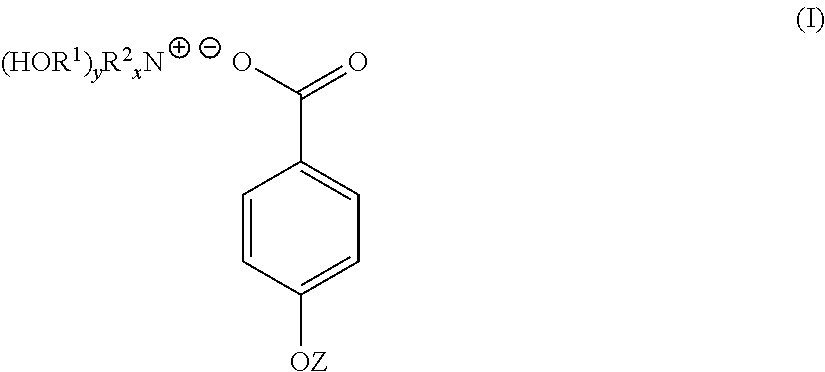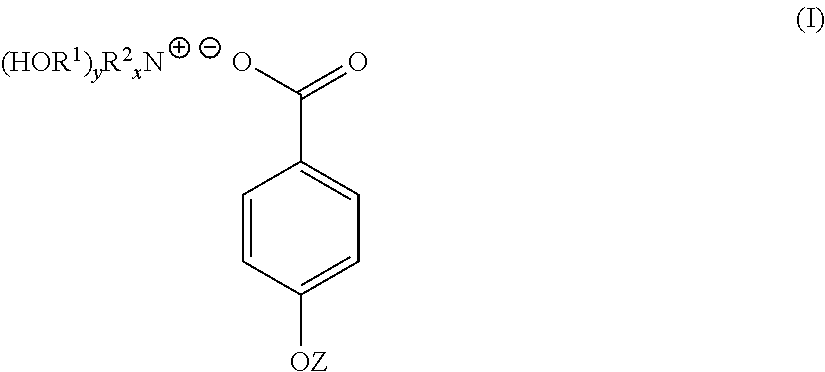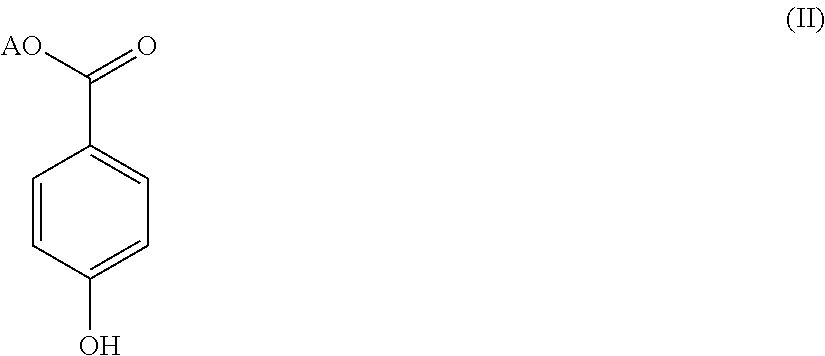4-hydroxy benzoate derivatives for use in the treatment of infection, inflammation or pain
a technology of benzoate derivatives and derivatives, which is applied in the field of 4hydroxy benzoate derivatives for use in the treatment of infection, inflammation or pain, can solve the problems of limited or no effective preventative or curative treatment, infection, inflammation and/or pain, and the skin of a patient may be subject to steroidal treatmen
- Summary
- Abstract
- Description
- Claims
- Application Information
AI Technical Summary
Benefits of technology
Problems solved by technology
Method used
Image
Examples
example 1
Preparation and Characterisation of triethanolammonium 4-hydroxybenzoate (TEAB)
[0045]4-hydroxybenzoic acid (10.6 g, 0.08 mol) was dissolved in acetone (200 mL). To the 4-hydroxybenzoic acid solution was added a solution of triethanolamine (9.23 g, 0.07 mol) dissolved in a water (70 mL) / acetone (200 mL) mixture yielding a clear solution. The solution was stirred at room temperature for 1 hour. The solution was stripped of acetone on a rotary evaporator to yield 91 g (100%) of a light yellow solution with n20d of 1.3890. This light yellow solution was found to contain 30% by weight of TEAB in water. A sample of the light yellow solution was reduced to near dryness yielding a white crystalline solid identified as TEAB containing 0.3 moles of water per mole of solid (93-94 C).
[0046]To establish the ionic nature of TEAB, 10 g of the light yellow TEAB solution was blended with water (300 mL) and Dowex MB-3 ion exchange resin (Dow Chemical Company) and left to stand overnight. At this time...
example 2
Preparation of triethanolammonium 4-hydroxybenzoate (TEAB)
[0048]Triethanolamine (149 g, 1 mol) was dissolved in water (287 mL). To this solution was added solid 4-hydroxybenzoic acid (138 g, 1 mol) over a period of 3 to 4 minutes. As the solid 4-hydroxybenzoic acid was added it reacted and dissolved increasing the temperature of the reaction mixture 5° C. After overnight standing, 573 g (100%) of a light yellow TEAB solution was recovered with n20d of 1.4484 and pH of 6.61. 40 g of the light yellow TEAB solution was reduced to 23 g on a rotary evaporator and this solution poured into acetone (300 mL). After 72 hours, a white crystalline solid was filtered off, washed with acetone and oven dried at 60° C. (m.p. 93-94 C). Yield 19 g.
example 3
Preparation of tetraethanolammonium 4-hydroxybenzoate
[0049]1-bromoethanol (100 g, 0.8 mol) and triethanolamine (119 g, 0.8 mol) were added to absolute ethanol (300 mL) and heated to 60 C while stirring. No apparent reaction was observed. After 2 weeks at room temperature stirring the reaction mixture contained a white crystalline solid which was filtered off, washed with ethanol and oven dried at 60 C to yield 5 g of tetraethanolammonium bromide (m.p. 189 C).
[0050]A 45% by weight aqueous solution of potassium hydroxide (100 g, 0.8 mol) was added to water (200 mL). To this solution with stirring was added 4-hydroxybenzoic acid (111 g, 0.8 mol). The mixture was stirred for 12 hours at room temperature to yield a white crystalline solid which was filtered off, washed well with acetone and dried. The white crystalline solid was potassium 4-hydroxybenzoate (m.p. 214 C).
[0051]Tetraethanolammonium bromide (4.58 g, 0.026 mol) and potassium 4-hydroxybenzoate (7.16 g, 0.026 mol) were dissolve...
PUM
| Property | Measurement | Unit |
|---|---|---|
| weight | aaaaa | aaaaa |
| swelling | aaaaa | aaaaa |
| hydrophilic-lipophilic balance | aaaaa | aaaaa |
Abstract
Description
Claims
Application Information
 Login to View More
Login to View More - R&D
- Intellectual Property
- Life Sciences
- Materials
- Tech Scout
- Unparalleled Data Quality
- Higher Quality Content
- 60% Fewer Hallucinations
Browse by: Latest US Patents, China's latest patents, Technical Efficacy Thesaurus, Application Domain, Technology Topic, Popular Technical Reports.
© 2025 PatSnap. All rights reserved.Legal|Privacy policy|Modern Slavery Act Transparency Statement|Sitemap|About US| Contact US: help@patsnap.com



